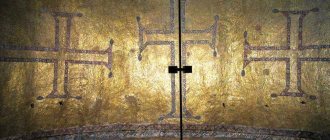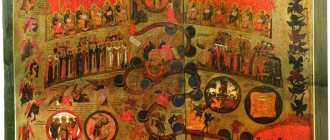The meaning of the word atonement is ransom
In the Bible, images from Old Testament times have a very significant influence. One of these images is ransom. This is the meaning of the word “redemption” in Holy Scripture. In the case of atonement, it is still the same legal process: Christ redeems humanity from the power of sin.
Jesus went to the cross to suffer the sins of mankind and give them a chance at redemption
When did humanity come under this power? Let's talk about this now. But first, a small note: the Judeo-Christian tradition is heterogeneous. Here we are talking specifically about the Orthodox concept of atonement..
Various sects, movements and interpreters may have a different view of the dogma of the redemption of mankind from sin, but our article does not aim to reveal the view of all Christian traditions.
The atoning Sacrifice of Christ is suffering for original sin
The circumstances of the origin of original sin are known to everyone: Adam, Eve, the serpent and the forbidden fruit. The essence of sin is neglect of the only law of God.
After this, the first couple of people are expelled from Eden, and a transformation occurs in their nature - into beings subject to sin. This is how the patriarchs of the Eastern Catholic Church wrote about it in 1723:
“We believe that the first man fell in paradise and that from here the ancestral sin spread successively to all posterity, so that there is not a single one born according to the flesh who is free from that burden and does not feel the consequences of the fall in this life.
But we do not call sin itself the burden and consequence of the fall, such as: wickedness, blasphemy, murder, hatred and everything else that comes from the evil human heart, in opposition to the will of God, and not from nature, but
inclination to sin and those disasters with which Divine justice punished a person for his disobedience, such as exhausting labor, sorrow, bodily infirmities, birth illnesses, a difficult life on earth for some time, wanderings, and finally physical death.”
Read on ABC ru: Message of the Patriarchs of the Eastern Catholic Church on the Orthodox Faith
There will always be those who want to argue, to say that God intentionally created the forbidden fruit, and the first sin was Cain’s murder of Abel. But we will simply continue to develop Orthodox thought.
The ancestors of mankind, according to Scripture, are responsible for the fact that humanity has become sinful, and now it requires redemption (“Adam and Eve”, a diptych by Dürer). Photo: upload.wikimedia.org
From the moment of the Fall, man became a damaged creature, which degraded again and again for thousands of years in a row. This predisposition prevented people from entering the spiritual world. Living without sin seemed impossible.
How to fix the situation? Some kind of mechanism was needed that would help people abandon the sinful choices of their ancestors and erase all sins from their biography. This mechanism became the redemption.
How exactly the atonement works is unknown to believers.
In Orthodoxy there is no complete theory of atonement. All attempts to formulate a coherent theology have failed. The atoning Sacrifice of Christ is beyond human understanding.
Holy Scripture teaches that it exists, that it acts. The Holy Fathers and other authorities of the Church agree with this idea. But we don’t know how it works, down to the small cogs.
Only brief information from the New Testament helps to lift the veil of secrecy.
We know for sure that redemption is one of the purposes of the coming of Jesus Christ to our world:
“The Son of Man did not come to be served, but to serve and to give His life as a ransom for many lives.”
(Matt. 20:28)
Repentance and atonement are the path to Salvation. The idea of redemption matured in God even before the creation of the world:
“For He chose us in Him before the foundation of the world, that we should be holy and blameless before Him in love, having predestined us as sons as sons through Jesus Christ.”
(Eph. 1:4)
The Atonement is to be treasured and cherished:
“You were bought with a price; do not become slaves of men.”
(1 Cor. 7:23)
Jesus Christ is not only the good shepherd for every sheep, but also the lamb who sacrificed Himself for humanity. This is how it is presented in the book of Revelation. True, his image is supplemented with various symbols: many eyes and horns, as well as a Book with seals. Photo: logosinfo.org
Jesus Christ took upon Himself the curse for the sins of mankind:
“Christ delivered us from the curse of the Law, taking the curse upon himself in our place, because it is said: “Cursed is the one who is executed on a tree.”
(Gal. 3:13)
The sacrifice of the cross is the central event of redemption
The entire earthly life of the Savior has a redemptive meaning, serving to reconcile man with God, but death on the cross occupies a very special place. The prototype of the Death on the Cross in the Old Testament was the Easter sacrifice, the slaughter of a lamb. John the Baptist connects his testimony about Christ precisely with this image: “Behold the Lamb of God, who takes away the sin of the world”
(John 1:29).
Being redemptive, Christ's sacrifice is substitutionary in nature. Christ dies completely freely, no necessity forces Him to go to the Cross: “I lay down My life, no one takes it from Me, but I myself lay it down”
(John 10: 17-18).
The words of the Symbol “for us”
focus our attention on the voluntary nature of Christ’s death, for as a sinner He had no need to die.
Christ died not His own death, but ours, “not because he could not avoid suffering, but because he wanted to suffer”
[1]
,
freely subordinating Himself to the conditions of our fallen nature in order to save us from damnation and death.
The Sacrifice of the Cross is the central event of the Redemption, the culminating moment of Christ’s entire ministry, about which He Himself said: “ At this hour I have come”
(John 12:27).
Why the death of the Son of God on the Cross is the central event of the Atonement is impossible to comprehend rationally; this is the greatest secret. However, some remarks must be made to help us understand the significance of this event in the work of Redemption. a) On the Cross, God’s love for man is revealed in its entirety. “... God proves His love for us by the fact that Christ died for us...”
(Rom. 5, 6) Death on the cross is the limit of self-abasement of the Son of God.
6) Death on the cross is the limit of self-abasement of the Son of God.
“He, being the image of God, did not consider it robbery to be equal with God;
but he humbled himself, taking on the form of a servant... he humbled himself, becoming obedient even to the point of death, even death on the cross” (Phil. 2:6-8).
Thus, the death on the cross seals the fullness of the Son’s obedience to the Father and, as a consequence, the fullness of the unity of the Son with the Father according to humanity. The expression of this unity are the words spoken on the Cross: “Father!
into Your hands I commend My spirit” (Luke 23:46).
Sin has distorted and twisted human nature, and Christ, through the feat of His entire life, the absoluteness of His obedience, “straightens out” the distortion of our nature. Death on the Cross thus completes the restoration of our fallen nature. But the limit of the humiliation of the Son of God is at the same time the transition to glory, the beginning of the glorification of Christ among humanity. The glory that the Son had with the Father “before the world was”
(John 17:5) according to the Divinity must now be revealed in His humanity, but the path to this glorification lies through the complete surrender of Himself to the Father, through the Cross and death.
“Therefore
(that is, as a result of obedience to death. - O.D.)
God also highly exalted Him and gave Him the name that is above every name, so that at the name of Jesus every knee should bow, in heaven and on earth and under the earth, and every tongue should confess that Jesus Christ is Lord to the glory of God the Father”
(Phil. 2:9-11).
c) If the Incarnation is victory over sin and the basis for restoring the union between God and man, then death on the cross is liberation from curse as a consequence of sin. Ap. Paul, referring to the words of Deut. 21:23 (“cursed is everyone who hangs on a tree”),
says:
“Christ has redeemed us from the curse of the law, having become a curse for us”
(Tal. 3:13).
The curse, which is “the condemnation of sin by the righteous judgment of God,”
is expressed primarily in the inaccessibility of communion with God for a person, in the separation of a person from God as the Source of life.
Death on the cross, removing the curse, returns this opportunity. “Christ accepts death of his own free will in order to transform the last consequence of human rebellion into freedom of love and obedience to the will of the Father”[2].
From this moment on, death for a person is no longer a dead end, but an entrance into the Kingdom of God.
The gates of heaven, closed after the expulsion of the ancestors, are opened again for man. This is confirmed by the words of the Savior addressed to the prudent thief: “Truly I tell you, today you will be with Me in Paradise”
(Luke 23:43).
d) The voluntary acceptance of death by the Lord Jesus Christ is also a necessary condition for victory over it. “And just as the children share in flesh and blood, He also took part in them, so that by death He might destroy the one who had the power of death, that is, the devil”
(Heb. 2:14).
“The only way to defeat death is to allow it to penetrate into God Himself, in whom it cannot find a place for itself.”[3]
Sin and evil could kill Christ, destroying His humanity, but they could not make Himself evil, subject Him to sin.
After the death of the Savior, the forces of evil could not restrain Him, for they had nothing in Him akin to themselves, over which they could rightfully extend their power. “... the prince of this world comes, and has nothing in Me”
(John 14:30).
Thus, the death of the Savior was a victory over death, and the Lord, “trampling down death by death,” [4]
revealed this victory in His Resurrection.
Jesus atoned for our sins by crucifixion
We all know the image of the crucifixion - that's how Jesus atoned for our sins. A person who sins must die in sin, perish. This is a kind of punishment for an ungodly life. This law is inexorable.
However, Jesus Christ offers a substitutionary sacrifice - Himself. In general, such a practice existed in the ancient world: people sacrificed slaves, captives, animals and firstborns.
It was assumed that God accepts this death instead of the one who brings it.
Christ gave every person the right to accept Him as the Savior and transfer their suffering to the Messiah, and, as it were, die to sin and be born to spiritual life.
The Creed says this:
“For our sake, man and our salvation came down from heaven and became incarnate from the Holy Spirit and the Virgin Mary, and became human.
She was crucified for us under Pontius Pilate, and suffered and was buried. And he rose again on the third day according to the Scriptures. And ascended into heaven, and sits at the right hand of the Father.
And again the coming one will be judged with glory by the living and the dead, His Kingdom will have no end.”
Read on Orthodoxy ru: Creed
The sacrifice of the cross is not only a spiritual, but also an edifying act. Jesus shows people an example of love and self-sacrifice. Photo: upload.wikimedia.org
The following questions persist in the Christian world:
- For whom did Christ die: for those who accepted Him or for everyone?
- How can the sacrifice of one atone for the sins of many?
- Is it possible to suffer in advance, even for those sins that have not yet been committed?
- Is it even correct to replace the sinner with Jesus?
- Can we consider that Jesus went to death for us if He rose again on the third day? Is this really a sacrifice? After all, death, it turns out, is not real.
Death of Jesus.
Execution or severed blood clot? The answers in the Christian world are different. Scripture itself does not directly address these topics, so much will depend on one's ability to interpret, reason, and debate.
Even among Orthodox priests there is no unity. One will tell you something that is completely opposite to the ideas of the other.
How We Can Benefit from the Saving Fruits of the Atonement Sacrifice
Christ “sacrificed Himself as if for all, and obtained grace and salvation for all; but those of us who, for our part, voluntarily take part in His sufferings, take advantage of this, being conformed to His death.”
(Phil. 3:10).”
We participate in the suffering and death of Jesus Christ a) through living heartfelt faith: “And it is no longer I who live, but Christ lives in me. And the life I now live in the flesh, I live by faith in the Son of God, who loved me and gave Himself for me”
(Gal. 2:19-20);
6) through the Sacraments: “Do you not know that all of us who were baptized into Christ were baptized into His death”
(Rom. 6:3).
“... as often as you eat this bread and drink this cup, you proclaim the death of the Lord...”
(1 Cor. 11:26).
c) by crucifying their flesh with its passions and lusts: “... those who are Christ’s have crucified the flesh with its passions and lusts”
(Gal. 5:24).
The crucifixion of sinful flesh is accomplished by “abstinence from passions and lusts, and actions contrary to them”
[12]
.
The dogma of the redemption of mankind from sin teaches that Jesus Christ made a sacrifice to Himself
According to Christian dogma, it was impossible to simply take and forgive people for their sins. Any damage during the recovery process requires suffering. We are sick and suffer until we recover.
So the agony of the cross is the torment that the Savior endures in our place. But to whom did Christ sacrifice Himself? God the Father? Let us turn to the reasoning of professor of theology A.I. Osipova:
“But from the words of Gregory the Theologian we see
that Christ was and accepts this sacrifice.
The suffering of Christ is
the suffering of Christ's humanity.
Therefore, it is not surprising that
that He is both a Priest and a Bishop.”
Alexey Osipov
theologian
That is, there were two natures in Christ. Therefore, one nature could suffer, and the second, whole, accept this sacrifice. What is the second nature of Christ? We are talking about Divine unity, about the Trinity.
Christians all over the world argue about who exactly Christ sacrificed for the sake of atonement: the Father, Himself, the Holy Spirit, or all at once. Photo: azbyka.ru
It was the Trinity that accepted the sacrifice of Christ, Professor Osipov continues:
“On the question of to whom the Sacrifice of Christ was brought, a council was even held in Constantinople at one time, in 1156 or 1157.
And there the teaching of the fathers was confirmed that the Sacrifice of Christ does not have the meaning that Catholics bring to it - that He brings the Sacrifice to the Father, the Sacrifice of satisfaction - no.
The Council decided that the Sacrifice was offered to the entire Holy Trinity.
How to understand this, what does it mean? We again turn to the point that we rarely pay attention to, namely, that the commandments (as well as breaking them, are sins)
- this is not a law given to us from outside, but this law is present in our nature, and by sin we do not violate an external legal law in relation to us, but we violate the laws of our
human nature, we damage ourselves or we heal ourselves in a certain way of behavior.
When we talk about the Sacrifice of Christ to the entire Holy Trinity, i.e. God in His trinitarian inseparability, then in fact we say that the Sacrifice was offered to the one who perished and turned out to be saved.
(After all, no one makes a sacrifice to himself). And man is God-created nature, organized according to Divine laws. Gregory Palamas says that God is the nature of everything that exists.
When we destroy our nature through sin, we resist God. We create this nature by doing the commandments - by doing this we please God, figuratively speaking. The sacrifice is made to the Holy Trinity - how? – through our nature.
The sacrifice offered through our nature, offered to our salvation, offered to us, is a sacrifice to God in the Holy Trinity.”
Alexey Osipov
theologian
Simeon the New Theologian writes on the same topic:
“Christ offered Himself in the flesh as a Sacrifice to the Divinity of the Father and the Son Himself and the Holy Spirit.”
Simeon
New theologian
Christ offered Himself as a sacrifice to the Trinity. The same idea is expressed by Gregory the Theologian. He also emphasizes that the atoning sacrifice was not made to the devil:
“What remains to be explored is a question and a dogma left unattended by many, but for me very much in need of investigation. To whom and for what purpose was this blood shed, shed for us—the great and glorious blood of God and the Bishop and the Sacrifice?
We were in the power of the evil one, sold into sin and bought damage for ourselves through voluptuousness. And if the price of redemption is given to no one other than the one in power, I ask: to whom and for what reason was such a price given?
If the evil one, then how offensive this is! The robber receives the price of redemption, receives not only from God, but God Himself, for his torment he takes such an immense payment that it would have been fair to spare us for it!
And if to the Father, then, firstly, how? It was not to Him that we were held captive. And secondly, for what reason is the blood of the Only Begotten pleasing to the Father, Who did not accept Isaac offered by the Father, but replaced the sacrifice, instead of a verbal sacrifice gave a ram?
Or from this it is clear that the Father accepts not because he demanded or had a need, but according to the economy and because man needed to be sanctified by the humanity of God, so that He Himself would deliver Us. Such are the works of Christ."
Gregory the Theologian
saint
The atoning sacrifice is the only basis of salvation
“Thou hast redeemed us from the legal oath with Thy venerable Blood”
The dogma of atonement is the heart of the Orthodox faith.
All dogmatic statements in the field of triadology, Christology, ecclesiology and soteriology were tested by the Church Fathers primarily in relation to the possibility of redemption and salvation of man by Christ. It is not only a criterion for the purity of faith, but also a stumbling block for heretics and false teachers from the apostolic age to the present day. The dogma of the atonement especially irritates liberal theologians who, like the ancient Jews, do not want to admit that Christ redeemed and freed them from the captivity of sin and the power of the devil. They believe that they were born free and will receive heaven as their ancestral inheritance, and they look at the Gospel as a guide to self-improvement. The dogma of atonement is alien to them - this is the unshakable foundation on which the New Testament Church is built.
In other religions and in almost all denominations, the dogma of atonement is absent or completely distorted. This dogma does not exist in Judaism. According to the teachings of the Talmud, Adam's sin does not extend to his descendants. A Jew is saved by fulfilling the instructions of the Torah and Talmud. The expected messiah does not deliver people from sin, but Israel from its enemies. The most sinful of the Jews suffer temporarily in hell, but will then receive forgiveness through the prayers of Abraham and other righteous people. Thus, Judaism contains a kind of national “apocatastasis”.
There is no doctrine of atonement in Mohammedanism. Fulfillment of the Koran and sunnah (tradition) serves as a guarantee of salvation for a Muslim. Mohammed is not a redeemer, but a messenger through whom Allah revealed his will to people. The Koran categorically denies not only the Christian teaching about the Sacrifice of Christ, but the very fact of the crucifixion. According to the teachings of the Koran, Christ was taken to heaven like the prophet Elijah, and Simon of Cyrene was crucified in His place (this idea was found already in the second century by the Gnostic Basilides). Muslims believe that all who profess Islam, no matter what sins they commit, will ultimately be forgiven and saved through the prayers of Mohammed and his successors. Thus, in Islam we see a confessional “apocatastasis”.
Buddhism also lacks the idea of any kind of atonement. Buddhism rejects the existence of deity as an absolute spirit. The thought of eternal life as a continuation of existence causes horror and disgust in a Buddhist; he seeks salvation in death, in immersing himself in a kind of mental vacuum where feelings, thoughts and desires are absent. This mental self-mortification is perceived by him as the highest metaphysical state. Nirvana - a breakthrough into an imaginary void and the experience of one's existence as anti-being, where there is no suffering - is the cherished goal of Buddhism.
Paganism, in the highest reaches of ancient and Hindu philosophy and mythology, knew nothing about the universal atoning sacrifice that God would make for humanity. In Hinduism, salvation is the dissolution of the individual in the cosmic, the cosmic in the meonic, the meonic in the absolute; personality as such disappears; the savior is Shiva - the Indian Satan who destroys worlds.
Only Christianity brought the joyful news to the world that humanity has been redeemed by the Blood of Christ. The pagan and Jewish world responded to this news with cruel persecution. The cross of Christ seemed madness to pagan philosophers, and to Jewish teachers - a humiliation of the Divine. However, already in the time of the apostles, heretics-Docetes appeared among Christians, who taught that Christ came to earth ghostly, in some kind of ethereal body. This heresy rejected the dogma of the atonement. If Christ did not take on human flesh, then His suffering is illusory, which means that atonement is also illusory and Golgotha itself turns into a stage where the role of an illusionist is played by the Son of God. This heretical doctrine of “divine deception” was so harmful and blasphemous that the Apostle John forbade Christians to allow preachers of Docetism into their homes or even to welcome them when they met.
Other Gnostics also denied the atoning Sacrifice of Christ the Savior. The first-century Gnostic Simon the Magus took with him a woman named Helen, a harlot from Tyre, and taught that his concubine was the image of the human soul, and he was the incarnation of a god or higher eon, who took the fallen woman into his fellowship. This condescension of the deity to the harlot replaces the atonement of Simon the Magus.
Digressing somewhat from the topic, we note the following. The confusing and dark teachings of Simon the Magus go something like this. The deity gives birth to thought - ennia; Ennia creates angels; they rebel against their ancestor and imprison her in the bonds of matter. Ennia passes into the body of Helen the Beautiful, because of whom Troy fell, and into Helen the Harlot of Tyre, whom Simon the Magus makes his companion. The vicious lives of women in whom ennia is embodied do not defile the ennia itself, and in the body of harlots it remains a pure spark of deity. This is the secret teaching of the Gnostics that the soul does not depend on bodily affairs, just as a royal prisoner does not lose his dignity because he is not in a palace, but in a dark dungeon. This means that you can indulge in vices and still remain clean.
Another Gnostic, Carpocrates, developed the teachings of Simon the Magus. He considered the body to be the constant enemy of the soul and taught that one must indulge in debauchery in order to exhaust and kill the body, and to enable the soul to quickly free itself from its oppression. Carpocrates considered the humiliation of the body through vices and debauchery to be the salvation of the soul and an analogue of redemption. This vile teaching of the Syrian Gnostics was subsequently presented to his readers by the Satanist writer Anatole France in the story “Thais,” where he presented prostitution as a form of atonement.
The second century Gnostic Basilides creates a theogonic system of 360 aeons according to the number of days of the year. Aeon Sophia falls out of the pleroma - the fullness of being and gets mired in the swamp of matter. Here one of the highest eons, Christ, descends upon her and, with the brilliance of his light, reveals to her the glory that she had while in the pleroma. Following Christ, Sophia returns to her heavenly abode. There is no redemption here. The famous church historian Robertson writes: “The doctrine of atonement was incompatible with the principles of Basilides. He admitted no other justification than justification by perfection in sanctification, and declared that each one would answer for his own sins" (History of the Christian Church, Robertson, 1 volume, 45. pages). Basilides denied original sin and the atoning sacrifice of Christ, and reduced everything to teaching.
The largest Gnostic of the second century was Valentin, who described the vicissitudes and wanderings of Sophia in the spirit of a detective-mystical novel. In contrast to Basilides, he allowed atonement, but in such a distorted and mutilated form that it had nothing in common with the apostolic teaching about the Sacrifice of Christ.
Valentine divided people into three groups: physical, mental and spiritual. To save spiritual people (pneumatics), knowledge of the Gnostic teachings was sufficient; they were saved regardless of their own deeds and moral precepts. For the soulful, among whom Valentine included church Christians, Jesus was crucified; before the crucifixion he was abandoned by the divine aeon-Christ and his own higher spirit. Through crucifixion, Jesus showed soulish Christians (psychics) how to improve themselves through suffering. Here there was an example, not an atoning sacrifice, and an effect similar to the catharsis of ancient tragedies. The spiritual, unlike the spiritual, could be saved or perish according to their deeds.
Every heresy involves a rejection or distortion of the dogma of the atonement. If there is no atonement, then Christological dogmas lose their meaning; they become indifferent to soteriology. Humanity could only be redeemed by the God-man, who has the fullness of Divine existence and the perfection of human nature. And Christ could give commandments and set a moral example, in the interpretation of the Gnostics, Monophysites and Nestorians.
If Christ is not the Redeemer, but a teacher, then Christology ceases to be necessary for salvation, since example and teaching are the external actions of the Divine in relation to man, and redemption is the replacement of man by the Son of God on the cross, that is, mystical ontology.
Why did Orthodox theologians and apologists fight so implacably against Arianism, considering this heresy a loss of eternal life? – Because the Son of God, not equal to God the Father and different from Him in nature, could not bring a perfect, infinite, in its dignity, sacrifice of atonement for all humanity, and become a Mediator between the Holy Trinity and the descendants of Adam.
Why has the Orthodox Church fought and continues to fight against Monophysitism for many centuries? Because Monophysitism distorts the dogma of the atonement. If Christ has one nature, then it is not clear who suffered on the cross, who died and was resurrected: after all, the Divinity is impassive and unchangeable. If Christ has one Divine nature, then how did the replacement of humanity with Christ take place on Calvary?
Nestorianism, with its teaching about the sinful nature of Jesus and about the two persons united morally in Him, perverts the dogma of atonement. If human nature is sinful, then suffering and death become consequences of sin, and not a voluntary sacrifice.
Catholics and a significant part of Protestants believe in the redemption of man by Christ, but the ecclesiological errors of their confessions do not give them the opportunity to benefit from the fruits of redemption.
Currently, there are active forces that want to reform Christianity in the spirit of humanism and liberalism, ridicule the doctrine of original sin inherited from Adam by his descendants, remove the atoning Sacrifice of Christ from soteriology and create a different Christianity in the Gnostic spirit, where Christ acts as a teacher, and only in this sense is he a savior. But even an imperfect deity, as the Arians represent Christ, can set an example and preach a new teaching.
Why then did Orthodox apologists fight against Arianism for several centuries? Why are Christians who did not accept the Arian Creed and suffered for it, martyrs and confessors, like those who did not renounce Christ during the time of pagan persecution? Christian apologists argued that if Christ is not equal with the Father, then our redemption through the Sacrifice of Calvary did not take place; it lost its axiological perfection, and the world remained unredeemed. One of the prominent modern reformers declared: “Christ saved me by teaching me how to overcome sin.” But didn’t humanity know what sin was before Christ? Was there no repentance in the Old Testament Church? In various philosophical and religious teachings of antiquity one can find analogues to the commandments of the Holy Scriptures, but there was no Christ the Redeemer and the Holy Spirit - the Sanctifier, therefore it was not possible to be saved. Why did the epiphanies in the Old Testament not save people, but the incarnation of the Son of God was necessary? The Lord appeared to Moses at Sinai, talked with him as if “face to face,” and gave commandments and detailed instructions about worship. But theophany (theophany) without incarnation and redemption could not free humanity from the slavery of Satan and the power of sin.
The Calvary Sacrifice is assimilated by man in the sacrament of baptism; it means that humanity has been redeemed by the Blood of Christ. In baptism, a person does not receive initiation, as in pagan theurgies, but puts on Christ. If a person is saved only by the example of Christ - how to live, then what does he receive in the sacraments of the Church? Why, before the Sacrifice of Calvary, could not the Holy Spirit come to people and form the Church of Grace? Why did Christ not come to earth immediately after the fall of Adam, but it took five thousand years to prepare humanity? If it's a matter of examples, then the entire history of the Old Testament is full of them. But why did people wander in darkness before the coming of Christ and the righteous went to hell after death? If it’s only a matter of teaching and example, then why are all the Christological dogmas needed, because Christ could come in a ghostly or angelic body and show an example of how and what should be done.
But only the God-man - with perfect divine and human nature in one Person - could redeem us. If Christ did not replace man with Himself, but only showed him, as in a picture, what needs to be done, then all disputes and dogmatic debates about the Face of Jesus Christ become meaningless. If there is no redemption, then a wide road opens for ecumenism and theosophy; Moreover, the doctrine of the unification of confessions and then religions is presented as the only Christian principle, and dogmatic differences and Council Oros are unimportant opinions that do not change the essence of Christianity, but, on the contrary, are barriers to the unity of faith and love. If Christ did not make an atoning sacrifice for me, did not replace me with Himself, but only taught me how to fight sin, then what do I care how two natures are united in His person, or how many wills - one or two - Christ has?
I should only be interested in how I, through my efforts, will reproduce the example of Christ in my life. All denominations agree that Christ taught good, that He suffered (phantom or real), and the rest, if there is no atonement, does not apply to my salvation. If there is no sacrifice for me, and the Gospel is a pedagogical manual with clear examples, then what do I care whether Christ is the God-man or a simple man who morally improved himself all his life and conquered his sin on the cross? If Christ is only a teacher, and not a Redeemer, then in this sense all the founders of world religions can be called “saviors,” since they taught what a person should be. Here Christ is placed on a par with Buddha, Mohammed, Confucius, Pythagoras and others. If there is no redemption, then what is the difference between theophany and the incarnation?
After all, the Lord spoke through Moses and the prophets. If it’s a matter of teaching, then what is the fundamental difference for me between Christ’s Sermon on the Mount and the voice coming from the Bush of Fire? If there is no redemption, but the point is edification and example, then the broadest possibility opens up for uniting Orthodoxy with anything and everything, then intercommunion will take the place of a common sacred meal, and theosophy, as the principle of unity in plurality, will become not only justified, but even necessary .
The moral theory of the atonement calls us to see Jesus as an example
35 miracles of Jesus Christ
Everything we have outlined above is called the legal theory of atonement. That is, there is a formal debt, and there is its objective payment.
This approach has been repeatedly criticized for the fact that it lacks an edifying spiritual message.
At the beginning of the 20th century, a moral theory emerged as a counterweight to legal theory. She says that Christ is not just the One who suffered for our sins. He is also a role model.
His sacrifice was made out of love, and it is an example as well as a call to all of us. This is not just a sacrifice for the sake of a sacrifice, not an action for oneself, not the implementation of a heavenly formality.
Two sides of Christ's sacrifice: a ransom for sinners and an example for believers.
Critics of moral theory reproach it for being down-to-earth. An example to follow is, from their point of view, an insufficient feat on the part of Christ. He clearly came to earth for something more.
But the debate itself is not being waged in Orthodoxy. They use an integrated approach, depending on the situation. Somewhere, the actions of Christ are an example, but the Savior remains the Savior.
By leaving a comment, you accept the user agreement








